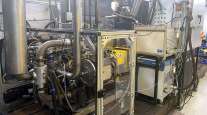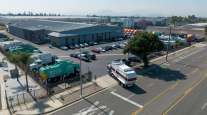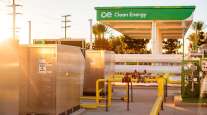Manufacturers See Promise in Natural Gas, Tell Fleets to Study CNG, LNG Differences
This story appears in the Nov. 5 print edition of Transport Topics. Click here to subscribe today.
CINCINNATI — A Volvo Trucks executive described natural gas as a significant “windfall” for the United States, and a manufacturer of natural gas fuel systems said truck buyers must parse a host of fine details before purchasing a vehicle.
“Customers want to save money on fuel, and they like that natural gas prices are de-coupled from crude oil,” said Volvo Senior Vice President Bill Dawson. “Manufacturing is returning to the United States and expanding, in part because of the new energy situation. As a nation, we have to make this work.”
Aside from refuse vehicles, trucks powered by natural gas are a small portion of what Volvo builds — 1% of the total, Dawson said. However, Volvo and other truck makers are interested in compressed and liquefied natural gas as truck fuels.
“We are, to an extent, making decisions without the normal business case approval. Some of this is a hope and a prayer, but no wants to risk seeing this take off without having a card on the table,” Dawson said here Oct. 30 at the Integer Research conference on diesel emissions and diesel exhaust fluid.
Also at the conference, a Westport Innovations executive offered a briefing on the finer points of CNG and LNG engines. Westport, Vancouver, British Columbia, makes natural gas fuel systems to use with truck engines. It works with Cummins Inc., among others.
John Crawford, a Westport director, dissected and analyzed the several variations of natural-gas engines, including two versions of LNG, two of CNG and two types of combustion. Crawford said LNG comes in two forms — cold and warm. The cold version is stored at minus-260 degrees Fahrenheit and really is a liquid, whereas “warm” is only minus-200 degrees, at which point it is a vapor.
The cold fuel needs a fuel pump and works well with high-pressure direct-injection, or combustion through compression. This makes for a dual-fuel engine that also needs some diesel, Crawford said.
That means the set-up also requires a diesel particulate filter and a selective catalytic reduction system. However, the advantages of HPDI are that it provides more power and can work with an automated manual transmission and an engine brake.
With warm LNG, Crawford said, there is no fuel pump, as the gas under pressure replaces the pump. This is burned as pure natural gas in a spark-ignited cylinder. Such an engine has less power, cannot use current automated manual transmissions and has difficulty linking with an engine brake. However, it needs neither a DPF nor SCR.
On the CNG side, spark ignition is more common, but there are backers of CNG with diesel in dual-fuel compression.
Crawford said slow-fill CNG versus fast-fill is an important distinction. The virtue of fast-fill — it saves time — is obvious, but the problem is not. When CNG is pumped quickly, it heats up and then expands. Therefore, hot CNG will appear to fill up a tank more quickly than is really the case.
Slow-fill CNG can take hours, rather than minutes, Crawford said, but the fueling apparatus is much cheaper and it fills the tank to its true capacity because slow-fill CNG takes on less heat and expands less.
Which system to pick depends on the details of a trucking company’s operations, so multiple options could exist over time, Crawford said.
Dawson and Crawford also discussed a potentially significant problem for natural-gas truck fuel — the venting of it into the atmosphere. Natural gas, they agreed, is a highly reactive greenhouse gas estimated to be 25 times more powerful than carbon dioxide.
Crawford said the fueling of a truck is a tightly controlled process. However, when LNG warms into a gaseous state from a liquid, pressure within a tank builds. Typically, if this gets to a critical level, some of the pressure is vented so as to prevent a full-scale rupture.
Dawson said the Environmental Defense Fund is investigating, and he welcomes them. “I think they’re helping us to get our arms around this issue. I think this research will lead to putting facts on the table, and that’s better than emotions. But I think natural gas is a windfall for us as a country and a people.”
Dawson also will be a panelist at American Trucking Associations’ Natural Gas in Trucking Summit, Nov. 28-30.




